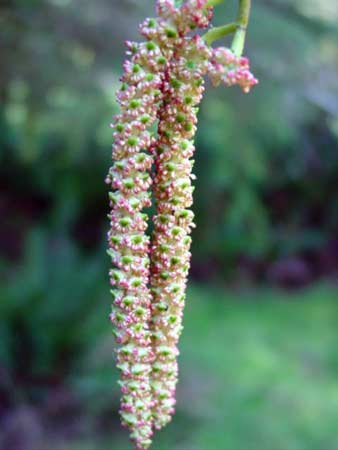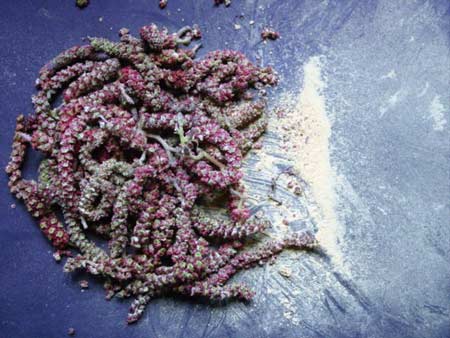 |
A Note on Eating Alder Catkins
|
| One fine day in mid-March, here on the Olympic Peninsula of
Washington State, found me scouting my new landscape for wild edibles.
Old salal berries, huckleberries, rose hips, various leaves and roots,
sweet hemlock tree cambium, licorice fern, earthworms—all fine tidbits
for the table. Since there were not many mushrooms this time of year to
draw my attention, I actually looked upward once in a while, a direction
my forage-vision doesn’t usually go. Leaf-out of deciduous trees and
shrubs had just begun, when I noticed that the red alders (Alnus rubra)
were sporting thousands of fresh catkins, or hanging spikes of male
flowers. |
 |
| |
|
|
| |
"Why not?" I asked myself as I pulled a catkin off its perch and
chewed on it. Along with a slightly nutty taste from the yellow, powdery
pollen, the catkin structure itself was crunchy and pleasing, if not a
little bitter.
The questions ran through my mind:
1.Are alder catkins edible?
2.Are they also digestible?
3.Does their nutrition warrant their collection?
Alder catkins and pollen: |
 |
| |
Around here, alders seem to limit their distribution to river banks,
lake shores and low-lying sedge bogs. They also do well at abandoned
homestead sites and on old logging roads, presumably due to the removal
of competitive species as pioneers cleared their land. In March, the
male (5-12cm) and female (2-4cm) catkins emerge just before the leaf
buds rupture. My focus here involves the male catkin and its edibility.
When eating a plant for the first time, I like to initially experience
it raw—usually any possible gastrointestinal irritation will manifest
itself at that time and I can then assess necessary preparation
techniques. For ten days I ate ten raw catkins in the morning. Then for
20 days I ate 20 boiled catkins (after drying and collecting the
pollen). At no time did I feel any ill effects.Boiled catkins: |
 |
| |
I have found one reference to eating alder catkins. The Plants for a
Future Database (www.pfaf.org), which holds ethnobotanical information
on over 7000 plant species, says that the catkins have been eaten raw or
cooked and are rich in protein. It also adds that the catkins are
astringent and have been chewed to alleviate diarrhea. Here I would add
that although I was initially concerned about the digestibility of
catkins, there have been no signs of incomplete-breakdown or of unusual
intestinal complications during the length of this experiment.
Catkin nutrition seems to have been little-studied, so I will divert my
focus to the pollen found in and on the male catkins. To walk from my
cabin to the nearest alder stand, pick a half-gallon of catkins (which
yields about six tablespoons of pollen), and return home takes about 90
minutes. If I may extrapolate from data regarding nutritional
composition of hand-collected pollen (www.fao.org), six tablespoons—or
roughly three ounces—of alder catkins pollen may contain:
- 0.6 oz of crude protein
- 1/3 oz of simple sugars
- 1/6 oz of crude fat
- 1/3 oz of starches
- all amino acids necessary for human health
- over 40 vitamins and minerals
- trace amounts of glucose oxidase, an antibacterial compound
Alder seedlings: |
 |
| |
| I find alder catkins to be a refreshingly seasonal dietary
addition, especially when boiled (I liken the taste to corn and
potatoes) seasoned with western coltsfoot ash-salt or added raw
to boiled worms. Boiled alder seedlings have also proven to be
meal-worthy. I will definitely enjoy them while they last and
look forward to experimenting with other catkin-bearing trees
and shrubs in the area. |
| |
| View this article as a
PDF |
|
|
|
 |
 |
 |



